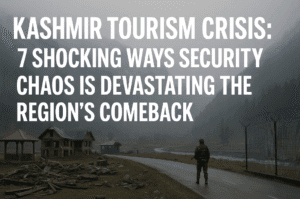Kashmir Tourism Crisis: 7 Shocking Ways Security Chaos Is Devastating the Region’s Comeback
India has closed 55% of Kashmir’s tourist sites following a targeted attack on Hindu travelers in Pahalgam that killed 26, derailing the region’s revival as a travel hotspot. Blaming Pakistan-based militants, India suspended a key water-sharing treaty, while Pakistan blocked Indian flights, escalating tensions between the nuclear rivals. The shutdown threatens livelihoods for 700,000 locals reliant on tourism, which contributes 7% to Kashmir’s economy, with businesses fearing prolonged losses during peak season.
Cross-border skirmishes have intensified, raising fears of broader conflict. Analysts warn the closures risk deepening local resentment, potentially fueling militancy in the insurgency-scarred region. As Kashmir’s alpine valleys empty, the crisis underscores the fragile balance between security and economic survival in conflict zones. The situation highlights how geopolitical strife can unravel years of progress, leaving communities caught between violence and viability.

Kashmir Tourism Crisis: 7 Shocking Ways Security Chaos Is Devastating the Region’s Comeback
A serene evening in Kashmir’s Pahalgam valley turned to horror last week when assailants singled out Hindu tourists, killing 26 in a execution-style attack. Survivors recount chilling details: armed men separated groups, demanded names, and opened fire at close range. This marked the deadliest assault on tourists in decades, abruptly halting Kashmir’s gradual revival as a travel destination after years of insurgency.
India’s Response: Lockdown on Tourism
In an unprecedented move, Indian authorities closed 48 of Kashmir’s 87 tourist sites effective April 29, including iconic Mughal gardens, trekking routes, and alpine valleys. Security forces now patrol remaining sites, but the government has not specified when—or if—these closures will lift. Local businesses, reliant on the busy summer season (April–September), face devastating losses. “This is our peak window. Without tourists, livelihoods collapse,” says a Srinagar-based hotel owner, echoing widespread anxiety.
Geopolitical Fallout: Old Wounds, New Measures
India swiftly blamed Pakistan-based militants, accusing its neighbor of orchestrating the attack to destabilize the region. Pakistan denies involvement, demanding an independent investigation. Tensions have since escalated:
- India suspended the Indus Waters Treaty, a 60-year-old agreement governing shared river resources, risking water disputes.
- Pakistan blocked Indian flights from its airspace, disrupting regional travel.
- Cross-border skirmishes intensified, with both sides reporting nightly exchanges along the Line of Control (LoC).
Analysts warn of a dangerous cycle. “Mistrust is entrenched. Each retaliatory step—water treaties, airspace, tourism—deepens the divide,” notes South Asia security expert Dr. Priya Menon.
Kashmir’s Tourism Paradox: Beauty and Fragility
Before the attack, Kashmir was rebranding itself as “India’s Switzerland,” with visitor numbers rising 25% annually since 2022. Social media buzzed with influencers paddling Dal Lake or hiking Himalayan trails. Now, viral videos show deserted resorts and evacuation pleas.
The closures strike at Kashmir’s economic lifeline. Tourism employs over 700,000 locals and contributes 7% to the region’s GDP. “Tourism was our bridge to normalcy,” says cultural historian Aamir Wani. “This setback risks reviving youth disillusionment—a recruitment pipeline for militancy.”
What’s Next?
- Human Cost: Families reliant on tourism face ruin. Artisans, guides, and houseboat operators report zero bookings.
- Security vs. Economy: Can India balance safety without crippling Kashmir’s economy? Long-term closures may fuel resentment.
- Diplomatic Pathways: With both nuclear-armed nations posturing, neutral mediation channels (e.g., UAE, UN) are critical to de-escalation.
The Bigger Picture
Kashmir’s crisis reflects a global dilemma: how regions recovering from conflict rebuild trust with visitors. While enhanced security is urgent, overreach risks alienating communities and perpetuating instability. For now, Kashmir’s valleys stand silent—a testament to the fragile interplay between peace and prosperity.
You must be logged in to post a comment.